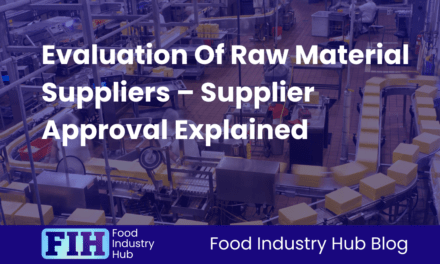Internal audits in food manufacturing are a valuable tool when it comes to identifying areas of improvement and increasing efficiency. They can help to identify weaknesses, strengths, and discrepancies in compliance, while also providing an opportunity to discover value-added activities that could be pursued. When done properly, internal audits can provide a thorough overview of a business’s operations and help to ensure that all areas are running effectively. The data collected from these assessments can then be used for performance management and decision-making purposes.
Internal Audits for Added Value, Not Just a Necessary Aspect of Compliance
Internal audits in food manufacturing are often viewed as a necessary aspect of compliance to meet regulatory requirements. However, internal audits can provide much more than just compliance assurance. When executed effectively, internal audits can add value to the organisation by identifying areas for improvement and opportunities for cost savings. By conducting routine internal audits, food manufacturers can identify gaps in their processes and systems before they become major issues that could result in product recalls or other significant consequences.
Internal audits also provide an opportunity for cross-functional collaboration within the organisation. By involving employees from different departments in the audit process, manufacturers can gain insights into how all aspects of the business work together and identify areas where further integration is needed.
While compliance is undoubtedly a principal motivator for internal auditing in food manufacturing, it should not be seen as its sole purpose. Through careful planning and execution of internal audits, food manufacturers can maximise their benefits by identifying areas for improvement that deliver financial gains while enhancing overall operational efficiencies.
Internal Audits Facilitate Continuous Improvement
Internal audits provide an opportunity for continuous improvement within the organisation. By identifying areas where processes can be improved or optimised, internal audits facilitate ongoing progress towards meeting business objectives.
One of the key benefits of internal audits is that they help organisations identify potential risks and hazards before they become major issues. By reviewing operational practices and procedures, auditors can spot potential safety concerns or issues with product quality early on, allowing manufacturers to take corrective action before problems escalate.
In addition to identifying areas for improvement, internal audits also help to promote a culture of accountability within the organisation. When employees know that their work is being reviewed regularly and that they will be held responsible for any deficiencies identified during an audit, they are more likely to take their responsibilities seriously and prioritise the delivery of high-quality results. Ultimately, this focus on quality enables food manufacturing companies to maintain customer trust while driving long-term growth and success.
The Benefits of Effective Internal Audits
An effective internal audit is an essential tool for food manufacturers to ensure compliance, identify areas for improvement, and enhance the overall efficiency of their operations. By regularly conducting internal audits, food manufacturers can improve process control, reduce waste, prevent product recalls and strengthen their reputation with customers.
Internal audits enable companies to evaluate their current systems and procedures against industry best practices and regulatory standards. The identification of gaps or deficiencies in these systems allows management to implement corrective measures before they become larger issues that could result in legal liabilities or damage the company’s reputation.
Internal audits can also provide valuable insights into financial performance metrics such as inventory turnover rates. By identifying areas where costs can be reduced or production efficiencies increased, internal audits contribute significantly to a company’s bottom line. Overall, effective internal audits are a critical component of any successful food manufacturing operation that is committed to continuous improvement and maintaining high standards of quality assurance.
Delivering Valuable Insights into Operational Systems and Processes
Internal audits help to ensure that operational systems and processes are working effectively, efficiently and in compliance with regulations. However, for internal audits to be truly effective, they must deliver valuable insights into the current state of the business.
One way to achieve this is by focusing on specific areas of the business during each audit cycle. For example, one audit cycle may focus on raw material handling while another could focus on cleaning procedures. By taking a targeted approach, auditors can provide deeper insights into specific areas of concern.
Using analytics tools to analyse audit data allows businesses to identify trends and patterns in their operational systems and processes over time. Armed with this information, they can make informed decisions about where improvements are needed and how best to implement them. Delivering valuable insights through internal audits is particularly helpful for driving continuous improvement in food manufacturing operations.
Sign-up for the Food Industry Hub Mail Service
We regularly produce new content for food industry professionals, and the Food Industry Hub Mail Service is the best way to stay up to date with the latest additions.
Signup today to be added to the Food Industry Hub mailing list.
Substantiated Verification of the Effective Application of The Food Safety Plan
Verification of the effective application of the food safety plan involves reviewing whether the implemented measures are achieving their intended purpose and ensuring that they comply with the relevant standards. The process also helps identify loopholes and gaps, enabling manufacturers to enhance their strategies for managing risks.
To achieve substantiated verification, a thorough assessment must be conducted by qualified personnel with relevant expertise. They will evaluate whether all aspects of the food safety plan have been implemented effectively and efficiently, including hazard analysis, preventive controls, corrective actions, monitoring programs, and more.
The substantiated verification process aims to ensure that manufacturers adhere to best practices in food safety management. Providing independent feedback on compliance levels allows businesses to identify areas where improvements are necessary to reduce risk exposure further. Ultimately this enables companies to protect consumers’ health while maintaining operational efficiency and minimising financial loss due to product recalls or other adverse impacts resulting from non-compliance.
Validation of Compliance Interventions for Food Safety and Quality
The importance of compliance interventions for food safety and quality cannot be overemphasised in food manufacturing. It is essential to have the necessary measures in place to ensure that products are safe for consumption and meet the required quality standards. However, it is not enough to put these measures in place; they must also be validated to ensure that they work as intended.
Validation ensures that the processes, procedures, and controls put in place are effective in achieving their intended purpose.
Internal audits play a crucial role in validating compliance interventions for food safety and quality. Through internal audits, manufacturers can assess their systems’ effectiveness regularly and identify areas where improvements are needed. This helps them stay on top of regulatory requirements while ensuring their products’ safety and quality standards are maintained consistently.
Dispassionate, Unbiased Feedback for Management and Stakeholders
In the food manufacturing industry, internal audits play a crucial role in ensuring that processes and procedures adhere to standard operating practices. However, feedback from these audits can be difficult for management and stakeholders to receive, especially when it is critical. That’s where dispassionate, unbiased feedback comes into play.
The key to effective internal audits is ensuring that they are conducted by an impartial auditor who has no vested interest in the outcome. This approach allows for honest observations and recommendations without fear of repercussions or bias. Additionally, this feedback should be presented in a clear and concise manner so that management and stakeholders can easily understand any issues or areas for improvement.
Incorporating dispassionate and unbiased feedback into internal auditing processes can help food manufacturers maximise the benefits of these audits. By providing honest insights without fear of bias or retaliation, companies can proactively address concerns before they become bigger issues while also promoting accountability and transparency throughout their organisation.
Actionable Information for Improvement Initiatives
The true value of an audit lies not just in identifying weaknesses but also in taking actionable steps to improve them. A well-designed corrective action plan can help companies prioritise and address issues identified during internal audits, leading to continuous improvement and increased efficiency.
Internal audits present an opportunity to collect information on the current state of performance and identify any gaps. The exact nature of compliance deficits should result in very specific and targeted actions that can be taken to remedy any shortfalls. Internal audit non-conformances are frequently treated as being interchangeable with operational non-conformities, but there is a distinction between proactive assessment (through internal auditing) and reactive incidents-handling. The outcomes from audits are less about ‘what went wrong, and what should we do about it?’ and more about ‘where are the compliance gaps, and what would be the best ways to introduce systematic changes to make operational processes more robust?’.
Establishing a Risk-Based Schedule of Internal Audits
For each activity, the outcomes from previously conducted audits should influence the frequency of future audits.
It is important to consider the outcomes from previously conducted audits. This means using the results of previous audits to determine how frequently future audits should be conducted. For instance, if a previous audit identified several non-conformities, it may be necessary to conduct a follow-up audit sooner than originally planned. On the other hand, if no significant issues were found during a previous audit, it may be appropriate to schedule subsequent audits less frequently.
Risk perception should also factor into audit scheduling – so activities that may pose risks to food safety, quality, authenticity, or legality should be audited more frequently than lower-risk activities. In addition to considering risk factors when scheduling audits, it is also important to prioritise areas of the facility that have higher risk levels. This may include areas where significant processing occurs or where ingredients are stored in large quantities for extended periods of time.
Taking a risk-based approach to audit scheduling can help companies maximise the benefits of internal audits while minimising disruption to production processes. By prioritising high-risk areas and ensuring that audits are conducted with sufficient frequency, companies can ensure that resource and attention is channelled to where it is needed most.
Distributing Audits Throughout the Year for Representative Sampling
To ensure representative sampling, it is recommended to distribute audits throughout the year. By distributing audits across different seasons and production cycles, manufacturers can capture variations in their processes that may affect quality and safety. This approach also ensures that all areas of the facility are audited at least once during the year, reducing blind spots and increasing overall compliance.
In a highly seasonal industry, conducting all audits during one season can lead to skewed results and an incomplete view of the overall process. By spreading out audits across different seasons, food manufacturers can gain more accurate insights into their operations and identify areas for improvement.
In addition, distributing internal audits across various locations can help companies obtain a wider range of data points that can be used to inform decision-making processes. Conducting location-specific assessments helps highlight unique operational differences between sites, which can be leveraged by management teams to enhance efficiency and standardise procedures where necessary. Ultimately, this approach leads to better outcomes for both businesses and consumers alike.
Where resource is limited by the number of auditors in the auditing team as well as time allocated to audits (relative to competing priorities and tasks), spreading audits across the year can help to overcome bottlenecks and mitigate peaks in workload. This applies both conducting audits and implementing remedial actions. It’s functionally superior to drip-feed the cost and time demand throughout the year than to try to audit all processes in one go.
Ensuring All Aspects of The Site’s Food Safety and Quality Systems Are Included in The Internal Audit Schedule
The audit schedule should comprehensively address all systems and processes that form part of the site’s food safety and quality systems. Every function with any impact on food safety, quality, authenticity and legality should be included.
The audit schedule should include a systematic approach that ensures every function is reviewed at least once per year.
The audit schedule should be tailored to suit the specific requirements of the site, taking into account factors such as product complexity, process variability, regulatory compliance requirements, and risk. The scope of each audit should be clearly defined, with objectives set for each audit.
Upon the full implementation of the schedule of audits, the site’s management should not be left in a position of uncertainty over suitability and effectiveness of its systems and processes.
Defining A Clear Scope for Each Audit
This means outlining specific areas or processes that will be examined during the audit, as well as any relevant regulations or compliance standards that must be adhered to. By doing so, auditors can ensure that they are focusing their efforts on the most important aspects of the business and avoiding unnecessary distractions.
A well-thought-out scope for each audit removes ambiguity from the process. There are clear success criteria for audits – have all aspects of the scope been sufficiently addressed? Do observations of conformity and non-conformity fully challenge the activities included in the scope? Does objective evidence collected during the audit comprehensively substantiate the conclusions arrived at?
Explicitly defining the scope of each audit allows for the system of audits itself to be challenged. This benchmark can be used to assess the successful or unsuccessful application of the internal auditing system. Likewise, objective benchmarking of completed audits against their scope can aid in standardisation and consistency across audits carried out by different auditors.
Evidencing Auditor Competency Through Training and Qualifications
The auditor should be knowledgeable about food manufacturing regulations, standards and requirements, as well as have a solid understanding of auditing principles and techniques. To evidence their competence, auditors can acquire relevant training and qualifications.
For instance, auditors can complete certified courses such as ISO 22000 Lead Auditor Training or HACCP Auditing from reputable institutions. These courses equip them with the necessary skills to undertake thorough audits that cover all aspects of food safety management systems. Furthermore, they provide them with updated information on regulatory changes and industry best practices.
Apart from acquiring certifications, auditors should also receive regular training and development opportunities to maintain their competencies over time. This could include attending seminars or workshops focused on food safety management system updates or participating in webinars hosted by professional bodies focused on internal auditing. Evidencing competency through training and qualifications is a crucial element in ensuring that internal audits deliver maximum benefits for food manufacturing organisations while maintaining consumer trust in their products’ safety and quality standards.
The Importance of Auditor Independence, and Why Auditors Cannot Audit Their Own Work
Auditor independence is all about the auditor’s ability to perform their duties without being influenced by any conflicts of interest or undue pressure. Auditors must maintain independence in both fact and appearance, which means that they should avoid any actions or relationships that could compromise their impartiality.
Auditors cannot audit their own work because it creates an inherent conflict of interest. If auditors were allowed to evaluate their own performance, there would be no accountability for errors or oversights. This would undermine the credibility and effectiveness of the audit process, as well as erode trust in the results.
Identifying Conformity as Well as Non-Conformity
Conformity refers to adherence to industry standards, regulations, and best practices. In contrast, non-conformity denotes deviations from these benchmarks, which can have severe consequences for food safety and quality.
An internal audit should serve as an assessment of the degree to which a food business complies with a particular standard – not just a list of shortcomings. This is to provide stakeholders with a dispassionate and balanced measure of performance, so that the management team knows where systems and controls are working appropriately as well as where gaps introduce vulnerability. The outcome should be more like a SWOT analysis (strengths, weaknesses, opportunities, threats) than a list of failings.
Collecting and Retaining Objective Evidence for Audit Observations
Objective evidence is the foundation of any audit observation. In food manufacturing, it is vital to collect and retain objective evidence that supports audit observations. Objective evidence can be in various forms such as records, documentation, interviews or physical evidence. The auditors should ensure that they have gathered sufficient and reliable objective evidence to support their findings.
To collect objective evidence effectively, internal auditors must understand the requirements of the standard being audited and prepare a checklist with relevant criteria. The auditor must then identify the sources of information within the organisation where they can obtain objective evidence from. This information includes data on production processes, quality checks, equipment maintenance logs, staff training records and so on.
Once objective evidence is collected, it needs to be retained for future reference. This means storing it securely in a central location accessible only by authorised personnel for an appropriate amount of time. Retaining accurate records is critical as this will enable management to make informed decisions based on past audit findings affecting business continuity and improvement initiatives while ensuring food safety standards are maintained.
Determining Gaps Between Current Performance and Compliance Requirements
One of the key goals of internal auditing is to identify gaps between current performance and compliance requirements. These gaps can arise from a range of factors such as process inefficiencies, deviations in standard operating procedures (SOPs), or lack of training for employees.
To determine these gaps accurately, it is essential to conduct a thorough evaluation that covers all aspects of the food production process and governance systems. To illustrate, if a site operates according to the BRCGS Food Standard, an audit should compare documented management systems (policies, procedures, work instructions, etc) with the requirements of the standard; and then compare actual working practice with the expectations of the management systems. This will form a gap analysis between the documented management systems and the compliance standard in addition to an assessment of operational compliance.
Clearly Defining the Nature of Non-Compliance
Any instances of non-compliance identified should be explicitly defined. It isn’t enough to record a non-conformance – the exact nature of the non-conformance must be clearly interpretable to the person responsible for the activity, as well as any interested stakeholders.
Clearly defining non-compliance is that it helps manufacturers assess the level of risk associated with each issue. This information can help them prioritise corrective actions based on the severity of the risk and allocate resources accordingly. By addressing high-risk issues first, manufacturers can minimise potential harm to consumers and reduce their exposure to legal and financial risks.
Finally, clear definition of non-compliance facilitates communication between different departments within a manufacturing facility. By providing detailed information about audit non-conformities, employees responsible for fixing problems can work together more efficiently across departments towards a common goal – ensuring compliance with all relevant regulations and standards.
Reporting The Results of Internal Audits to The Person Responsible for The Activity
Once the internal audit has been completed, it is important to report the results to the person responsible for the activity being audited. This can help them identify any areas where they may need to improve their processes and make necessary changes. Additionally, reporting the results of internal audits can increase accountability among team members and promote a culture of continuous improvement.
When preparing to report on internal audit results, it is important to be clear and concise in your communication. Focus on providing actionable feedback that will enable the person responsible for the activity to make improvements quickly and effectively. It is also important to ensure that you are communicating in a way that is appropriate for your audience – some people may prefer written reports, while others may prefer face-to-face meetings or phone calls.
Forming An Agreement Over Corrective and Preventative Actions Needed, and The Timescales for Their Implementation
One of the key benefits of conducting internal audits in food manufacturing is that they help identify gaps and areas for improvement. However, identifying these issues is just the first step; it’s important to form an agreement over corrective and preventative actions needed to address them. This agreement should involve key stakeholders from different departments, including production, quality control, and management.
Once gaps and areas for improvement have been identified in internal audits, it is important to take action to address them. This involves developing a thorough plan that outlines the steps needed to close any identified gaps or improve processes within the food manufacturing operation. It’s critical to involve all relevant personnel from different departments in this process, as they can offer unique insights and suggestions for improvements.
The agreement should include specific timescales for implementing these actions. It’s important to set realistic deadlines that take into account any potential challenges or obstacles that may arise during implementation. By setting clear timescales and involving all relevant parties in the process, you can ensure that everyone is aligned on what needs to be done and when it needs to be done by. If a corrective action requires a significant investment in new equipment, it may be necessary to adjust the timeframe accordingly. Similarly, if there are staffing shortages or other issues that could impact progress, these should be factored into the schedule.
Verifying The Effective Completion of Remedial Actions
Verifying the effective completion of remedial actions is crucial in ensuring that internal audits are effective in improving food manufacturing processes. It involves confirming that the corrective actions recommended during an audit have been taken and are producing the desired results. The verification process should be documented to ensure effectiveness and accountability.
To verify the effectiveness of remedial actions, it is important to establish clear criteria for success before implementing them. This will help to determine whether they have achieved their intended objectives. Verification can be done through follow-up inspections or by reviewing data collected after implementing the corrective action.
Validating That Compliance Is Satisfactorily Achieved Following Corrective and Preventative Actions
One of the essential aspects of internal audits in food manufacturing is to ensure that corrective and preventative actions are taken after a nonconformity has been identified. But it’s not enough to implement these actions; it’s equally important to validate them to confirm that compliance has satisfactorily been achieved. This validation process involves evaluating the effectiveness of the corrective and preventative measures and determining if there have been any recurring non-conformities.
One way of validating the efficacy of corrective and preventive actions is by conducting follow-up audits. During these audits, auditors can determine if the action plans were implemented as specified or if there were any deviations from what was outlined in the plan. The findings from this audit can then be compared with previous audit results to ascertain if progress has been made towards achieving compliance.
Direct observation during regular operations can also be used to validate whether corrective and preventive actions have led to compliance or not. For example, observing employees following standard operating procedures or using equipment correctly could indicate that these actions have indeed led to improved compliance levels. Ultimately, validating that compliance is satisfactorily achieved following corrective and preventative actions helps organisations identify areas for improvement and make necessary adjustments, leading to better overall performance metrics.
Summarising The Results of Internal Audits into Management Review Meetings
Following a thorough and systematic approach, internal audits evaluate the effectiveness of company processes, identify areas for improvement, and ensure that compliance requirements are being met. Summarising the results of these audits is an important step towards maintaining quality standards.
Management review meetings provide an opportunity to discuss audit findings and assess how well current processes align with company goals. These meetings allow management to take a holistic view of operations and determine whether changes need to be made to improve efficiency or reduce risk. This is an expression of senior management commitment. By summarising audit results in clear, concise language, it becomes easier for management to make informed decisions regarding future course of action.
In addition to identifying areas for improvement within the company, summarising internal audit results also provides insight into staff performance. It allows management to recognise employees who have consistently met or exceeded expectations and highlight areas where additional training may be required. This information can then be used as part of employee evaluations or professional development plans, ultimately contributing towards a more efficient workforce.
Identifying Trends Across Functions and Departments
By analysing data from various departments, such as production, quality control, and purchasing, companies can identify areas for improvement and take necessary actions. For example, if the trend shows a high number of quality control issues in a particular department, further investigation can be conducted into why this is occurring and what measures need to be taken to address it.
This can help to identify patterns that may indicate areas for improvement or potential issues. For example, if there is a consistent problem with contamination in a particular area of the facility or during a specific stage of production, this could be an indication that additional training or equipment is needed.
Identifying trends across functions and departments also helps companies to better understand how their processes are interconnected. This understanding can lead to more streamlined operations and improved communication between different teams. For instance, if a trend shows that delays in purchasing are leading to delays in production, steps can be taken to improve communication between these two departments so that delays are minimised.
Identifying trends across functions and departments should be an integral part of any internal audit program. It allows companies to gain insights into their processes that might otherwise go unnoticed while facilitating improvements that increase efficiency and effectiveness throughout the organisation. By identifying patterns in these areas that could lead to non-compliance with regulations or a drop in product quality, companies can take proactive steps to address issues before they escalate.
Allocation Of Resources, Assessment of Skills, and Management Capacity in Light of Trended Audit Results
It is necessary to allocate adequate resources for the implementation and maintenance of audit programs, including hiring staff with relevant skills, training them accordingly, and investing in technology and infrastructure. The assessment of employee skills also plays a significant role in these efforts. Companies should regularly evaluate their employees’ performance, identify skill gaps, and provide appropriate training to improve capabilities.
Management capacity is another key factor that can impact the effectiveness of internal audits. Good management practices are essential to ensure that audit findings are responded to appropriately and corrective actions are implemented timely. Management should be responsible for developing guidelines or policies based on audit results that can help improve processes and prevent future issues or risks identified during an audit. They must also communicate effectively with all stakeholders involved in the audit process by sharing information transparently with them about any deficiencies found during an audit to develop collaborative solutions.
The identification of numerous or recurring non-conformities at audit should be a strong signal that a department or function is in need of additional resource.
Determination Of Future Audit Frequency Based on The Findings of Completed Audits
If a food manufacturing company has many significant issues that need to be addressed, then more frequent audits will be necessary. However, if only minor issues were discovered during an audit, then less frequent audits may suffice.
Regular follow-ups should be conducted by food manufacturing companies after each audit cycle; this assists in ensuring that all identified corrective actions have been implemented successfully while also providing an opportunity for further improvement suggestions. By doing so, companies can make sure they are meeting regulatory requirements and maintaining quality standards while avoiding costly non-compliance fines or product recalls.
In Summary
Internal audits in food manufacturing are an essential component of ensuring the safety and quality of products. By conducting regular audits, companies can identify potential issues before they become major problems that could harm customers or damage their reputation. These audits should be thorough and comprehensive, covering all aspects of the production process.
To maximise the benefits from internal audits, it is important to have a clear understanding of what is being audited and why. Companies should establish audit protocols that are tailored to their specific needs and objectives, taking into account industry best practices and regulatory requirements. They should also ensure that their auditors are well-trained and knowledgeable about food safety standards.
Finally, it is critical for companies to take action based on the results of their internal audits. This may involve making changes to production processes, implementing new procedures or training programs for employees, or investing in new technologies or equipment. By following these steps and prioritising internal auditing as a key part of their operations, food manufacturers can help ensure that they produce safe and high-quality products while maintaining customer trust and loyalty.















